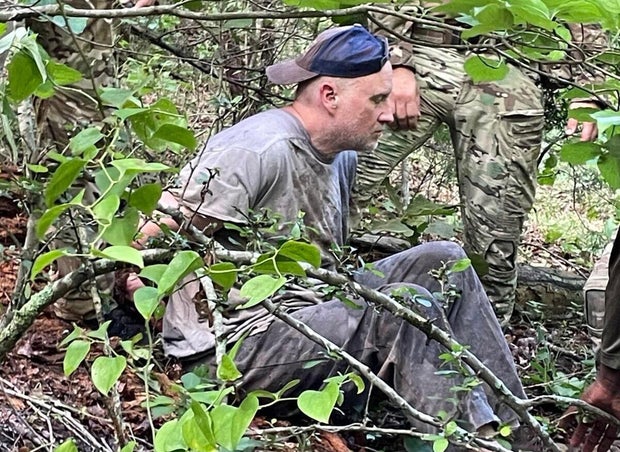A former police chief known as “Devil in the Ozarks” spent months planning his Escape Arkansas prisonAnd said lax security in the kitchen where he worked allowed the convicted murderer to bring together the supplies he needed, according to an internal examination.
Critical examination of incidents of the Arkansas Correctional Services Department Grant HardinOn May 25 Escape of Calico Rock prison, obtained by the Associated Press, provided the most detailed description of its planning and the problems that allowed it to get out of the establishment.
Hardin was apprehended on June 6“At a short distance” from the prison. Follow -up dogs were Capable of picking up a perfumeAbout one and a half mile west of the northern central unit of the prison. It was initially believed that Hardin can have fled the state.
Arkansas Correctional Services Department
Authorities used canines, drones and helicopters to browse the rugged land in northern Arkansas, and faced challenges in search of areas while heavy rains hit the area at the time.
The authorities said that he had escaped by carrying an outfit he had designed to look like a law application uniform.
Hardin, who worked in prison cooking, said he spent six months planning his escape and using black Sharpie markers and a laundry he had found in the kitchen to create the false uniform, according to the report. Hardin shaped a false badge using the cover of a box.
“Hardin said he would hide the clothes and other articles he was going to need a trash can in the kitchen because no one was shaking,” said the report.
Two prison employees were dismissed for procedural violations that led to the escape of Hardin. They include an employee of the kitchen who authorized Hardin on a rear quay without surveillance and a tour goalkeeper who unlocked the back door that Hardin crossed without confirming his identity. Several other employees were suspended and a recovery, have been informed of the legislators this week.
The kitchen staff was “very lax on security,” said Hardin to investigators, allowing him to bring together what he needed for his escape. Hardin said he had no help from the staff or other detainees. Hardin had built a ladder from wooden pallets in case he was to develop the fence of the prison but did not need it.
“(Hardin) said when he headed for the door, he simply ordered the officer to open the door,” and he did it, “said the report.
After escaping from the prison, Hardin survived the food he had denounced the prison with water distilled from his CPAP machine. Hardin has also drank stream water and ate bays, bird eggs and ants.
“He said that his plan was to hide in the woods for six months if necessary and start to move west of the region,” said the report.
Hardin was previously the police chief of the small town of Gateway, Arkansas. He was the subject of the television documentary “Devil in the Ozarks”.
Hardin served several sorrows after pleading guilty of both rape and murder, CBS News previously reported. He pleaded guilty to a first degree murder for having fatally killed James Appleton, 59, in 2017 and was sentenced to 30 years in prison. While he was imprisoned in this case, the police equaled his DNA to samples taken from a 1997 rape case. Hardin pleaded guilty to two rape chiefs in 2019, according to the affiliate of CBS KFSM, and was sentenced to 25 years for each charge.
The report is one of the two journals on Hardin Escape, which is also the subject of an investigation by the police of the state of the Arkansas. A legislative subcommittee has also held hearings on escape.
The Republican State representative Howard Beaty, who co-chaired the sub-comity of charitable, criminal and correctional institutions of the Legislative Council, said that the panel hoped to discuss two reports with officials at a hearing next month.
The senator of the republican state Ben Gilmore, who seated in the panel, said that he did not think that the ministry’s examination had a sufficiently deepened look at the systemic problems that allowed Hardin’s escape.
“They focused on the final failure instead of all the things that led it,” he said.
The report also cites confusion among the managers of the correctional services at the early stages of the Hardin escape to which the law enforcement organizations had been informed, the report said.
“It is obvious that there was a lot of confusion during the first stages of the opening of the command center and the notifications made,” said the report.
Hardin had been poorly ranked and should not have been detained in prison mainly at average security, according to the magazine. After being captured, Hardin was transferred to a maximum security prison. He pleaded not guilty to escape accusations and his trial is scheduled for November.
The classification of the Hardin guard had not been examined since October 2019, the report indicates.
The examination of the State Correctional Services Department indicates that the officials had taken several measures since the escape of Hardin, in particular by removing the electric locks from the doors to prevent someone from leaving without a present officer.
The report also provides additional cameras after finding a blind spot on the platform used by Hardin and in any “Shakedown” smuggling to include mechanical chambers and side rooms.



